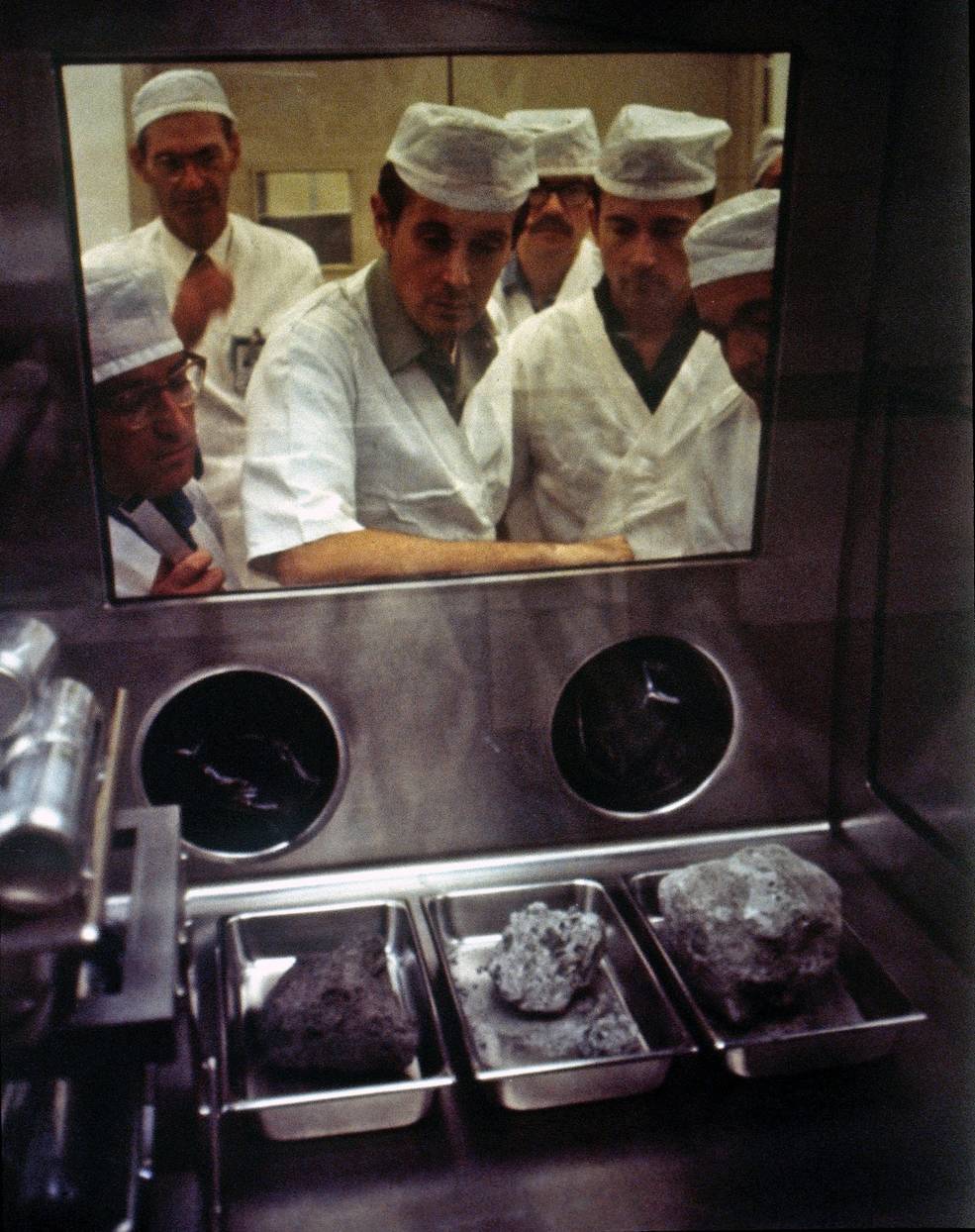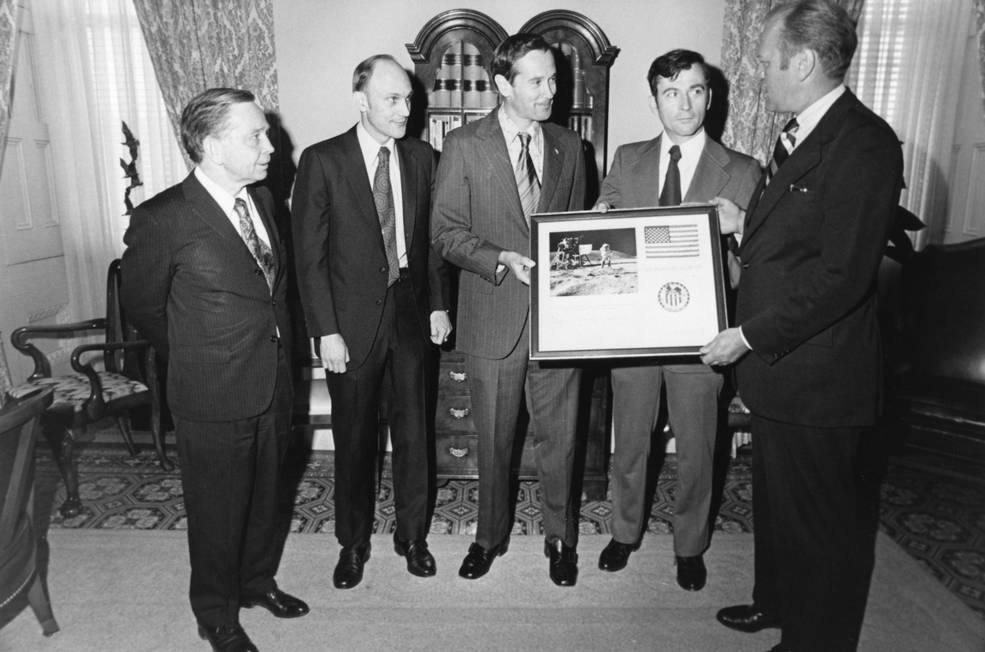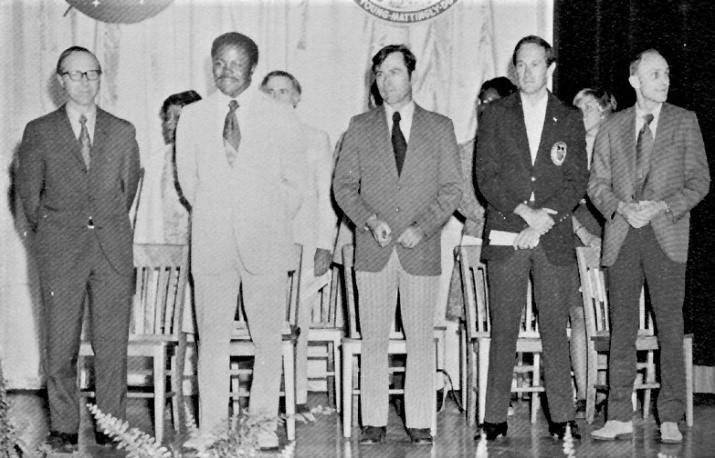Following their April 27, 1972 splashdown that ended their successful 11-day Moon landing mission, Apollo 16 astronauts John W. Young, Thomas K. “Ken” Mattingly, and Charles M. Duke began their journey home to Houston. After spending one night aboard the prime recovery ship U.S.S. Ticonderoga and a brief stop in Honolulu, they boarded a jet bound for Houston where they reunited with their families. They returned to work the next day to begin debriefings of their mission. The lunar samples they collected returned via separate jets to Houston while their Command Module (CM) Casper sailed to California, eventually returning to its manufacturer for detailed postflight analysis. Young, Mattingly, and Duke embarked on a 36-city tour of the U.S. to share their mission with the public.


Left: Apollo 16 astronaut John W. Young, right, addresses the crowd at Ellington Air
Force Base in Houston, as Charles M. Duke, left, and Thomas K. “Ken” Mattingly
and their families look on. Right: Young, left, Mattingly, and Duke during
the postflight crew press conference.
Apollo 16 splashed down in the Pacific Ocean 215 miles southeast of Christmas Island, and within 37 minutes recovery crews delivered Young, Mattingly, and Duke to the deck of the Ticonderoga. Following a topside welcome reception, they received thorough physical examinations from flight surgeons in Ticonderoga’s medical facilities. President Richard M. Nixon telephoned them with his congratulations and invited them and their wives to dinner at the White House. They took their first shower in 11 days and ate their first non-space meal at the captain’s table. During a reception, each astronaut thanked the ship’s crew for the efficient recovery. They spent their first night back on Earth aboard the recovery ship while it steamed north toward Hawaii. By the next day, the ship was close enough that an aircraft flew them to Hickam Air Force Base (AFB) on Oahu, where a crowd of 2,500 people, including the Governor of Hawaii John A. Burns, greeted them and presented them with copper plaques bearing an etching of Hawaii’s state capitol. From there, a U.S. Air Force C-141 Starlifter transport jet flew them non-stop to Houston’s Ellington AFB, where they reunited with their families and gave speeches to hundreds of well-wishers who turned out that evening to welcome them home.


Left: In the Lunar Receiving Laboratory, Apollo 16 astronauts Charles M. Duke,
second from left, and John W. Young examine some of the rocks they returned
from the Moon’s Descartes landing site. Right: “Big Muley,” the largest
returned from the Moon to date.
By the next morning, Young, Mattingly, and Duke reported back to work at the Manned Spacecraft Center (MSC), now NASA’s Johnson Space Center in Houston, to begin nearly two weeks of technical debriefs. The first batch of the 209 pounds of lunar samples arrived in Houston about five hours ahead of the crew, and over the next several days scientists began their initial examinations. In MSC’s Lunar Receiving Laboratory, Young and Duke examined some of the samples they collected, including “Big Muley,” named after William R. “Bill” Muehlberger, principal investigator for Apollo 16 geology and one of the geologists who had trained them before the mission. At 26 pounds, it remains the largest single Moon rock returned to date. On May 3, they held their postflight crew press conference, showing a film of their mission and answering reporters’ questions. On May 16, in Washington, D.C., Young, Mattingly, and Duke addressed a Joint Session of Congress and attended a state dinner in their honor.


Left: Apollo 16 astronaut Thomas K. “Ken” Mattingly addresses a Joint Session of Congress as John W. Young and Charles M. Duke listen. Right: As Speaker of the House Carl B. Albert, left, looks on, Apollo 16 astronauts Mattingly, Duke, and Young present a plaque commemorating their mission to Gerald R. Ford, right, House Minority Leader.
Young, Mattingly, and Duke traveled to NASA’s Kennedy Space Center (KSC) in Florida on May 25, to thank the employees there who launched them into space on April 16. In a ceremony in the cavernous Vehicle Assembly Building, where workers had begun stacking the Saturn V rocket for Apollo 17, the final Apollo Moon landing mission, they thanked the 8,000 assembled employees for a safe launch. To KSC Director Kurt H. Debus, they gave a plaque that included American and Florida flags that flew with them to the Moon and back. On June 15, President Nixon honored his promise by hosting Young, Mattingly, and Duke and their wives for dinner. In a meeting that also included NASA Administrator James C. Fletcher, they gave the President a photo montage of their mission and a flown American flag. The astronauts also gave a model of an Apollo and a Soyuz spacecraft – a joint mission that Nixon agreed to with his Soviet counterparts during their Summit meeting in Moscow the previous month.


Left: At NASA’s Kennedy Space Center (KSC) in Florida, Apollo 16 astronauts
Thomas K. “Ken” Mattingly, left, Charles M. Duke, and John W. Young present
a plaque commemorating their mission to KSC Director Kurt H. Debus.
Right: At the White House, Duke, NASA Administrator James C.
Fletcher, Young, and Mattingly present a model of the
Apollo-Soyuz Test Project to President Richard M. Nixon.
Like previous crews, the Apollo 16 astronauts embarked on a tour of the U.S. to talk about their mission. They appeared in 36 cities and towns, including their hometowns – Orlando, Florida, for Young, Auburn, Alabama, for Mattingly, and Lancaster, South Carolina, for Duke – where they received hero’s welcomes including parades. They traveled to New York City, where Mayor John V. Lindsey received them, they attended a showing of “A Funny Thing Happened on the Way to the Forum,” and attended a dinner hosted by U.S. Ambassador to the United Nations George H.W. Bush and his wife Barbara. In Chicago, Mayor Richard J. Daley threw a parade for them. They talked to an estimated 350,000 people during their travels, in cities large and small, always to enthusiastic audiences. Following their tour, NASA assigned Young and Duke, with Stuart A. Roosa replacing Mattingly, to the backup crew for Apollo 17, the final Apollo mission planned for December 1972.


Left: In St. Louis during their postflight tour of the United States, Apollo 16 astronauts
John W. Young, center, Charles M. Duke, and Thomas K. “Ken” Mattingly
speak to high school students at Harris Teachers College. Right: In New
York City, Young, center, Mattingly, behind Young, and Duke, right, with
the cast of “A Funny Thing Happened on the Way to the Forum,” with
U.S. Ambassador to the United Nations George H.W.
Bush, third from left.
As a result of the parachute collapse during the Apollo 15 landing, traced to dumping of Reaction Control System propellant during the descent that damaged the parachute lines, NASA decided to no longer dump the fuel during the descent. Once Casper arrived aboard the carrier, engineers with the Apollo landing and recovery team depressurized Casper’s propellant tanks during the Ticonderoga’s trip to Honolulu. From there, workers transported Casper to San Diego, arriving at North Island Naval Air Station on May 5. Sailors offloaded the spacecraft and in a portside hangar technicians safed the spacecraft from pyrotechnic devices. Casper departed by truck for its place of manufacture, the North American Rockwell plant in Downey, California, on May 12, where engineers thoroughly inspected the spacecraft. Today, Casper is on display at the U.S. Space and Rocket Center in Huntsville, Alabama.


Left: Apollo Landing and Recovery Engineers Frank Janes, left, and J. Milton “Milt” Heflin
safe the Apollo 16 Command Module Casper aboard the U.S.S. Ticonderoga following its
recovery. Right: The Apollo 16 Command Module Casper at the U.S. Space and Rocket
Center in Huntsville, Alabama. Image credit: courtesy U.S. Space
and Rocket Center.























